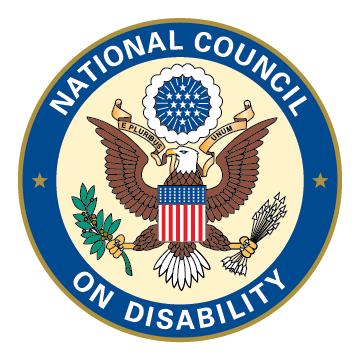Letter to Secretary Kennedy regarding MAHA Commission
April 7, 2025
The Honorable Robert F. Kennedy, Jr.
Secretary of US Department of Health & Human Services
200 Independence Avenue, S.W.
Washington, D.C. 20201
Dear Secretary Kennedy,
I am writing in my capacity as Vice Chair / Acting Chair of the National Council on Disability (NCD), an independent, bipartisan federal agency that advises Congress, President, and his Administration, regarding President Trump’s February 13, 2025 Executive Order (EO), “Establishing the President’s Make America Healthy Again Commission” (MAHA Commission), to offer to assist the Commission’s mission in any capacity you’d find helpful with our expertise in areas of its purview.
The EO notes that six in 10 Americans have at least one chronic disease, and four in 10 have two or more; and that Americans’ life expectancy lags behind other developed countries. The EO states, “We must ensure our healthcare system promotes health rather than just managing disease.” NCD agrees.
As a further subset of the American population that cuts across every demographic, people with disabilities experience even starker health disparities than the general population. Today, in the United States, if you are a person with a physical, intellectual, or developmental disability, your life expectancy is less than that of someone without disabilities.1 You are more than three times as likely to have arthritis, diabetes, and a heart attack.2 You are five times more likely to report a stroke, Chronic Obstructive Pulmonary Disease and depression.3 You are more likely to be obese.4 You are significantly more likely to have unmet medical, dental, and prescription needs.5 If you are a woman with a disability, you are likely to receive poorer maternity care and less likely to have received a Pap smear test or a mammogram.6
In 2009, NCD issued a comprehensive report titled “The Current State of Health Care for People with Disabilities,” in which we highlighted the numerous challenges that people with disabilities face when accessing health care, and the stark health outcome disparities that exist as a result.7 In 2022, we offered advisement to policymakers within a framework that seeks to end the health disparities experienced by people with disabilities and improve health care access and experiences of Americans with disabilities, sharing the EO’s goal to prize health promotion and disease prevention.8
NCD’s health disparities work has been informed by what we consider a “dream team” of interdisciplinary experts that have helped advise the Council’s deliberations, including practicing physicians, members of the allied health professions, academics, and researchers. With the benefit of their in-the-field insights, the policy expertise of NCD, and NCD’s established knowledge of the disability community, inclusive of families with children with disabilities – on whom the MAHA Commission is initially principally focused – I believe we can offer added value to the MAHA Commission’s work – both its discussions and deliberations as well as in review of its draft deliverables to ensure that the unique considerations of America’s population of people with disabilities, who are a part of every community, are also reflected. If invited to join, present to, or otherwise assist the Commission in any capacity, NCD is prepared to do so immediately. If NCD can assist the Commission’s mission through any means, please do not hesitate to contact me. We stand ready to serve.
Respectfully,
David Shawn Kennemer
Vice Chair, Acting Chair
-—————
1 Forman-Hoffman, V. L., Ault, K. L., Anderson, W. L., Weiner, J. M., Stevens, A., Campbell, V. A., & Armour, B. S. (2015). Disability status, mortality, and leading causes of death in the United States Community Population. Medical Care, 53(4), 346–354. https://pubmed.ncbi. nlm.nih.gov/25719432/.
2 Williams, M., Campbell, J., Zhang, Y., Felty, W., Harnden, A., Bannister, E. & Williams, V. (2020, Oct. 24-28). Exploring Health Disparities Among Individuals with Disabilities Within the United States, American Public Health Association [Paper presentation], American Association of Public Health, Virtual. https://apha.confex.com/apha/2020/meetingapp.cgi/Paper/473208.
3 Williams, M., Campbell, J., Zhang, Y., Felty, W., Harnden, A., Bannister, E. & Williams, V. (2020, Oct. 24-28). Exploring Health Disparities Among Individuals with Disabilities Within the United States, American Public Health Association [Paper presentation], American Association of Public Health, Virtual.
4 Kharn, G., Klein, W., & Correa-De-Araujo, R. (21015). Persons with disabilities as an unrecognized health disparity population. American Journal of Public Health, 105(S2), 198-206.
5 Mahmoudi, E., & Meade, M. A. (2015). Disparities in access to health care among adults with physical disabilities: Analysis of a representative national sample for a ten-year period. Disability and Health Journal, 8(2), 182–190. https://doi.org/10.1016/j.dhjo.2014.08.007.
6 Nosek, M. A., & Howland, C. A. (1997). Breast and cervical cancer screening among women with physical disabilities. Archives of Physical Medicine and Rehabilitation, 78(12), S39–S44. https://doi.org/10.1016/s0003-9993(97)90220-3.
7 National Council on Disability, “The Current State of Health Care for People with Disabilities” (2009), https://www.ncd.gov/report/the-current-state-of-health-care-for-people-with-disabilities/.
8 National Council on Disability, “Framework to End Health Disparities of People with Disabilities (2022), https://www.ncd.gov/report/framework-to-end-health-disparities-of-people-with-disabilities/.

